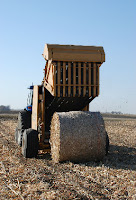
Separating corn stover into three parts and processing them separately could improve the efficiency of cellulosic ethanol production, a Purdue University study has revealed.
When corn stover is processed to make cellulosic ethanol, everything is ground down and blended together. But the researchers found that three distinct stover parts – the rind, pith and leaves – break down in different ways.
“Today, researchers grind the parts together and treat it based on what’s needed to get at the hardest part,” says Eduardo Ximenes, a research scientist in Purdue’s Laboratory of Renewable Resources Engineering. “We show that there are major differences in degradability among the tissues.”
Stover’s pith, the soft core that makes up more than half the weight of a cornstalk, is the easiest for enzymes to digest, according to the findings in two papers published in Biotechnology and Bioengineering. Rind is the most difficult, while leaves fall in between. Significant amounts of lignin make the cellulose resistant to hydrolosis, a process that breaks cellulose down into sugars.
Converting the rinds only adds about 20% more ethanol while requiring 10 times more enzymes, driving up the price of the process, Ximenes says.
“Is that extra 20% worth the added cost?” asks Nathan Mosier, ag and biological engineer and co-author of the study. “Because if there is a way to separate out pith, you could burn the leftover rinds to generate steam, creating energy needed to operate the plant.”
Separating pieces of corn stover and treating them differently would be a new way of approaching cellulosic ethanol production, adds Michael Ladisch, also a Purdue ag and biological engineer.
“It uses existing conversion technology, but it enables us to think about a new way of getting the most from that technology,” says Ladisch. “There is absolutely no reason a ligno-cellulosic non-food material such as cornstalk cannot be used to make ethanol if you understand the science.”
Ladisch, Ximenes and colleagues will next explore ways to improve the ability of enzymes to create sugars from cellulose and remove the compounds that inhibit those enzymes. They’ll also work to adapt the findings for other feedstocks, such as switchgrass and wood.
source: hayandforage
Dividing Stover Improves Ethanol Production
Friday, October 28, 2011 | Ethanol Industry News | 0 comments »
Subscribe to:
Post Comments (Atom)





0 comments
Post a Comment